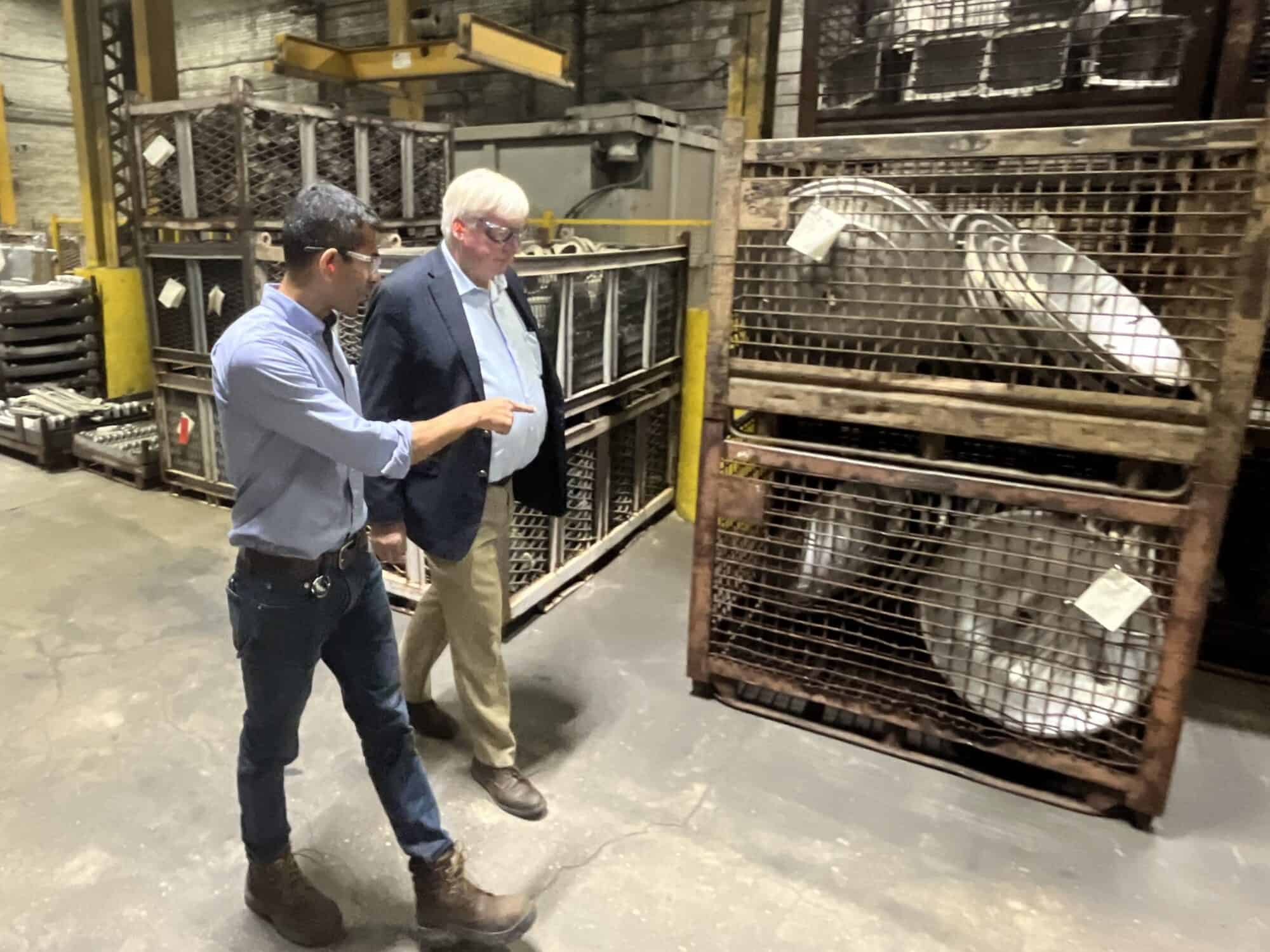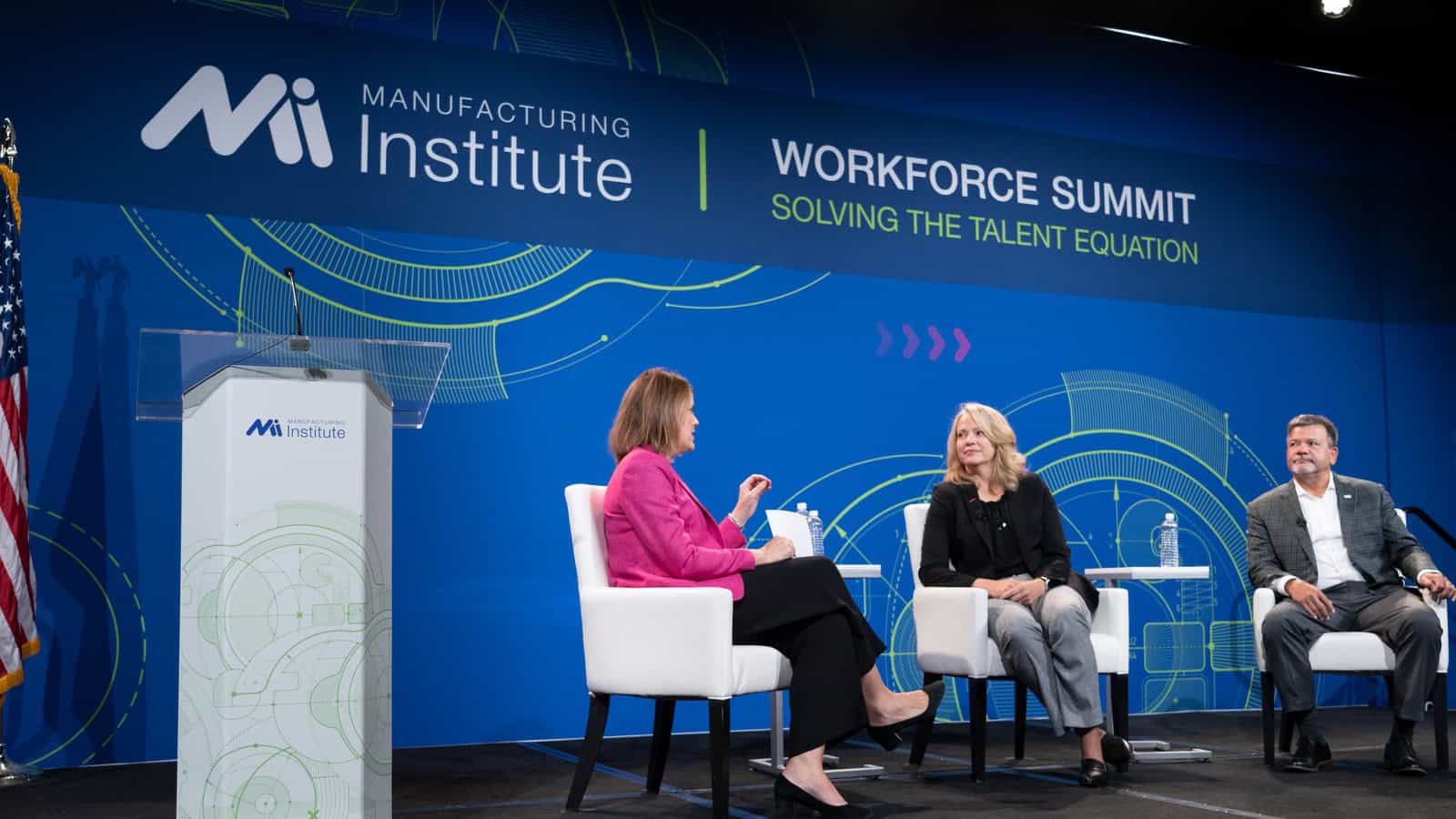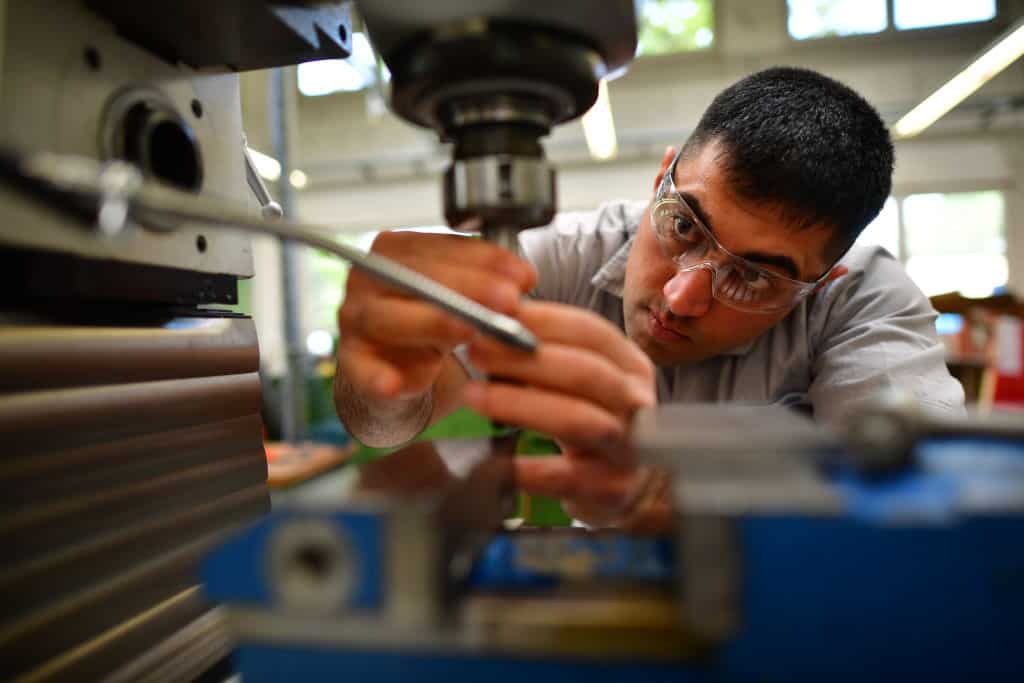Route 250 Diner: Testing the Power of Business

In a politically divided time, the NAM set out to answer an important question: Can businesses build trust, brighten views about America’s creators and rekindle belief in the American Dream? The answer, tested over three-and-a-half days at the Circleville Pumpkin Show in Ohio: “Yes, they can—and we probably should,” said NAM Managing Vice President of Brand Strategy Chrys Kefalas.
Why it matters: Declining American pride is more than just a cultural shift—it’s a business problem. “When people lose faith in the American Dream, they lose faith in manufacturers and the business community’s ability to drive progress, leading to skepticism, division and fewer supporters of the environment that manufacturers and businesses need to succeed,” said Kefalas.
- This challenge comes at a pivotal moment: America’s 250th anniversary—its Semiquincentennial—arrives in 2026. This milestone offers a once-in-a-generation opportunity to reignite pride and belief in the country’s future.
What we built: With funding from Stand Together Trust, the NAM and its partners developed the Route 250 Diner, a pop-up experience that combined stories about community creators, snack giveaways, career resources and service opportunities. It brought together businesses, trade groups and civic organizations to see if they could elevate creators locally and nationally while inspiring civic pride and acts of service.
The results: Nearly 4,700 visitors of many ages and political affiliations pledged to undertake service opportunities and shared overwhelmingly positive feedback. Some even contributed cash to survey boxes as a gesture of gratitude. The concept clearly resonated.
- “We need more of this,” “Love this” and “I hope y’all be back” were frequent refrains among survey respondents. “I believe that how towns like Circleville go, so goes America,” said Circleville Mayor Michelle Blanton. “What resonates here can inspire communities across the country.”
Leading brands take part: The concept won early supporters like Snap-on, Johnson & Johnson and The J.M. Smucker Company, as well as growing enterprises like Seaman Corporation and Centrus Energy. The Honda–LG Energy Solution battery plant joint venture team participated on-site, highlighting the 2,200 job opportunities at the new plant in Fayette County, Ohio.
- The National Restaurant Association and the International Franchise Association, which represent two vital sectors of the American economy, joined the effort, as well as state business groups The Ohio Manufacturers’ Association and the Ohio Restaurant & Hospitality Alliance.
Support: The NAM set out to complement national and state efforts to celebrate America’s 250th anniversary and promote civic education. The concept enjoyed the participation of the congressionally chartered, nonpartisan U.S. Semiquincentennial Commission (America 250), state-chartered America 250-Ohio, the Bill of Rights Institute and the Edward M. Kennedy Institute.
What they’re saying: Gov. Mike DeWine (R-OH) highlighted the initiative on social media, focusing on advancing participants’ career aspirations. “Empowered individuals and driving positive change in their communities are vital to America’s next 250 years,” said Stand Together Vice President Sarah Cross, stressing another key point of the activation.
- NAM President and CEO Jay Timmons: “By strengthening civic pride, inspiring acts of service and deepening our connections to our communities, we can ensure that manufacturers and enterprises across the nation shape a brighter future for America.”
- America250 Chair Rosie Rios: “The Route 250 Initiative is an important celebration of America’s creators and makers who play a vital role in strengthening our communities through meaningful acts of service as we approach America’s 250th anniversary in 2026.”
- National Restaurant Association President and CEO Michelle Korsmo: “The Route 250 Initiative reminds us that in every community, there are people creating opportunities for themselves and others—and that’s something worth celebrating as we help more people learn how to make America’s next 250 years better than our first.”
- Bill of Rights Institute President and CEO David Bobb: “By engaging in meaningful, constructive dialogue and celebrating the individuals who by their hands, hearts and minds are creating a better future, we can inspire a renewed commitment to those enduring ideals.”
- America 250-Ohio Executive Director Todd Kleismit: “By sharing stories of creators and community heroes and inviting us all to learn what we’re doing to serve our community, we’re not just celebrating the past—we’re inviting people to see themselves in America’s future.”
- The Ohio Manufacturers’ Association President Ryan Augsburger: “As we look ahead to America’s 250th anniversary, Ohio manufacturers will continue to lead the way. This diner and the Route 250 Initiative give us the chance to reflect on our past while also inspiring the next generation to shape the future—one innovation, one community, one creator at a time.”
- Ohio Restaurant & Hospitality Alliance Managing Director of External Affairs and Government Relations Tod Bowen: “As we look ahead to America’s 250th anniversary in 2026, we’re reminded of the importance of spaces like this. The diner invites us all to reflect on how we’re contributing to our communities and how, by coming together, we can make the next 250 years even better.”

The big takeaway: “At the heart of this proof of concept is a message: manufacturers, creators and communities all play essential roles in writing the next chapter of America’s story,” said Timmons. “This is a model, showing how civic pride, community service and the power of industry can renew belief in the American Dream.”
- “Some argue that no single narrative can unite the American people, but the Route 250 Diner and manufacturing’s story in America prove otherwise,” Kefalas added. “The question isn’t if we can find a unifying narrative—it’s who will step up to lead it, and that’s why we tried to show the way forward.”
What’s next: The NAM will evaluate the full results of the proof of concept with its partners and other key stakeholders, continuing to look for ways of using America’s 250th anniversary to strengthen the industry and the country.
In the news: POLITICO Influence covered the launch announcement, and The Scioto Post of Pickaway County, Ohio, previewed the experience.
More: Watch highlights of the grand opening event.
Housing Permits Drop, But Single-Family Home Starts Show Strength
Building permits fell 2.9% in September and are 5.7% lower than September 2023. Permits for single-family homes were 0.3% higher than August but were down 1.2% in the past year. Permits for buildings with five or more units plummeted 10.8% from August and are down a significant 17.4% in the past year.
In September, housing starts decreased 0.5% over the month and 0.7% over the year. On the other hand, starts for single-family homes were up 2.7% from August and 5.5% from September 2023. Meanwhile, starts for buildings with five or more units declined 4.5% from August and were down a dramatic 15.7% from September 2023.
Housing completions in September were down 5.7% from August but up a significant 14.6% from September 2023. Single-family home completions were down 2.7% from August to 1 million but up 1.6% over the year. Completions for buildings with five or more units dropped 8.7% over the month but were 41.9% higher than September 2023.
Fuel Prices Drive Sharp Decline in U.S. Imports, Exports in September
U.S. import prices declined 0.4% in September, following a 0.2% decrease in August. This is the largest one-month drop since a 0.7% decline in December 2023. Over the past year, import prices have edged down slightly (down 0.1%). U.S. export prices fell 0.7% in September, extending the 0.9% decline in August. While nonagricultural export prices contributed to the decrease (down 0.9%), agricultural export prices rose 0.6%. Over the past year, export prices fell 2.1%.
Fuel import prices decreased 7.0% in September, after declining 2.9% in August. Over the past year, fuel import prices have fallen 17.3%, the largest 12-month drop since August 2023. While petroleum prices declined a significant 16.7% over the year in September, natural gas prices fell an even more dramatic 57.4%.
Nonfuel import prices ticked up 0.1% for the third straight month in September. Higher prices for nonfuel industrial supplies and materials, consumer goods and automotive vehicles in September more than offset lower prices for foods, feeds and beverages.
After declining 2.1% in August, agricultural export prices advanced 0.6% in September. Over the past 12 months, agricultural export prices dropped 5.3%. On the other hand, nonagricultural export prices decreased 0.9% in September, with lower prices for nonagricultural industrial supplies and materials and automotive vehicles more than offsetting higher prices for capital goods, consumer goods and nonagricultural foods. Over the past year, nonagricultural export prices fell 1.8%, the largest annual decrease since December 2023.
Philadelphia Manufacturing Sees Growth, Price Pressures Remain
In October, Philadelphia’s regional manufacturing activity expanded overall. The index for current general business activity rose from 1.7 to 10.3. More than 24% of firms reported increased activity this month, while 14% reported decreases and nearly 57% reported no change. The indexes for new orders and shipments also increased and turned positive. On the other hand, firms reported a decrease in employment after rising last month, with the employment index falling back into negative territory at -2.2.
Both price indexes edged down but continue to indicate overall increases in prices. The prices paid index declined from 34.0 to 29.7 but remains at an elevated level that reflects the notable portion of firms experiencing higher input costs. The prices received index also fell and remained significantly lower than the prices paid index at 17.9, exhibiting how manufacturers are eating a portion of those higher costs paid.
Looking ahead, most future indicators increased. The index for future general business activity rose markedly to 36.7, indicating growing optimism among firms. A higher proportion of firms still expected increases in activity. Additionally, the new orders, shipments and future employment indexes also rose. On another positive note, the future prices paid index decreased, while the future prices received increased. On the other hand, the future capital expenditures index moved down slightly.
October Sees Decline in NY Manufacturing, Future Outlook Brightens
Manufacturing activity in New York state retreated in October after rising in September, with the headline general business conditions index falling 23.4 points to -11. The new orders index dropped 19.6 points to -10.2, after climbing to a multiyear high last month, while the shipments index fell 20.6 points to -2.7, exhibiting a decline in both orders and shipments. Unfilled orders edged down to a slightly negative reading of -2.2, while inventories shrank from 0 to -7.5, indicating inventories are in decline again. Delivery times were somewhat shorter, while supply availability deteriorated slightly.
Despite the decline in business activity, employment increased, with the index for the number of employees rising 9.8 points to 4.1. The average employee workweek also improved some, signaling a slight increase in hours worked. Input and selling price increases remained modest, as reflected in the prices paid index rising 5.8 points to 29.0 and the prices received index moving up 3.4 points to 10.8. Since prices paid continue to increase at a faster pace than prices received, manufacturers still face rising costs while operating in a weakened pricing environment.
Despite weak business conditions in October, firms felt much more optimistic about the future. The future business activity index rose 8.1 points to 38.7, a multiyear high, with nearly 55% of respondents expecting conditions to improve over the next six months. The capital spending index also reversed its losses from September, rising to 9.7 in October.
Manufacturing Output Falls in September, Aerospace Hit Hard
Industrial production fell 0.3% in September after advancing 0.3% in August. The decline in September was influenced significantly by the strike of Boeing workers and the effects of two hurricanes. Manufacturing output decreased 0.4%, with aerospace and miscellaneous transportation equipment dropping a dramatic 8.3%. At 102.6% of its 2017 average, total industrial production in September was down 0.6% from the same month last year. Capacity utilization edged down to 77.5%, 2.2 percentage points below its long-term average from 1972 to 2023.but was up 1.2% from the same month last year.
In September, major market groups saw mixed results. Among consumer goods, the production of durables decreased 0.7%. On the other hand, the index for nondurables increased 0.5%, helped by a 1.7% rise in energy goods. The business equipment index declined 3.5% in September, weighed down by the sharp 14.2% drop in the production of transit equipment, largely affected by the strike.
Durable goods manufacturing decreased 1.0%. Apart from the dramatic drop in aerospace and miscellaneous transportation equipment, declines occurred in motor vehicles and parts (down 1.5%), furniture and related products (down 1.5%) and electrical equipment, appliances and components (down 1.4%), with slight declines in numerous other durable industry groups. Nondurable goods manufacturing, on the other hand, increased 0.2% in September, with the largest gains in petroleum and coal products (up 1.8%) and printing and support (up 1.0%).
Manufacturing capacity utilization decreased 0.4% to 76.7%, which is 1.6 percentage points below the long-term average.
Rep. Grothman Talks R&D, Taxes at Wisconsin Aluminum Foundry

Rep. Glenn Grothman (R-WI) visited Wisconsin Aluminum Foundry in Manitowoc, Wisconsin, as part of a series of facility visits from key members of Congress organized by the NAM. Rep. Grothman, representing a district with one of the largest percentages of its workforce employed in manufacturing, emphasized the importance of key tax policies that keep manufacturers competitive on a global scale.
During the visit, Rep. Grothman toured the facility with Wisconsin Aluminum Foundry CEO Sachin Shivaram and held a roundtable discussion with company and union leadership. Representatives from Wisconsin Manufacturers & Commerce also participated in discussions about the challenges facing manufacturers.
Innovation and R&D: Shivaram showcased the Foundry’s advanced aluminum and bronze casting capabilities during the tour. He also expressed concern about changes in R&D tax treatment, which have increased the cost of innovation.
- “R&D is essential to the future of our business,” said Shivaram, stressing that restoring full R&D expensing is crucial for manufacturers like Wisconsin Aluminum Foundry. With the expiration of first-year R&D expensing in 2022, the burden of financing R&D has become a major obstacle for small and medium-sized manufacturers.
- Rep. Grothman, who strongly supports restoring full R&D expensing, said, “Manufacturers need every incentive to innovate and grow. If we want to maintain our competitive edge, we need to ensure that tax policy encourages, not discourages, investment in R&D.”
Preserving tax reforms: The roundtable addressed the importance of preserving the 2017 Tax Cuts and Jobs Act, which benefited manufacturers by lowering the corporate tax rate and providing a 20% pass-through deduction for small businesses. These provisions are set to expire in 2025, creating uncertainty for manufacturers.
- Rep. Grothman pointed to Wisconsin’s manufacturing and agriculture credit as a model for federal tax policy going forward. The MAC, which substantially reduces state taxes on manufacturing income, has proven effective in supporting Wisconsin’s manufacturers.
- “We should look at expanding these kinds of targeted incentives nationwide,” Rep. Grothman said, noting that a similar approach at the federal level could bolster U.S. manufacturing and global competitiveness.
The local view: WMC President and CEO Kurt Bauer echoed the concerns about the expiration of the 2017 tax reforms.
- “If these tax provisions are allowed to expire, it would put significant strain on Wisconsin’s manufacturers,” Bauer said. “The ability to reinvest in equipment, innovation and workers is crucial for maintaining our global competitiveness, and losing these tax incentives would make that much harder.”
Workforce development: The roundtable also covered workforce development, a critical issue for an industry facing a shortage of skilled workers.
- Shivaram, who chairs the Governor’s Council on Workforce Investment, stressed the importance of expanding access to skills-based education and apprenticeship programs to meet the needs of modern manufacturing. “We need policies that help us train and retain the workforce of the future,” he said.
- Rep. Grothman echoed this sentiment, pledging to support federal workforce development initiatives that prepare workers for careers in advanced manufacturing. “A skilled labor force is the foundation of manufacturing’s future,” he said.
Closing thoughts: “It is critical that tax policy continue to support manufacturers, who are the backbone of our economy,” said Rep. Grothman. “If we allow tax reform to expire, it would result in devastating tax increases—stalling job creation and innovation. It’s on us in Congress to work together to preserve tax reform and encourage investment, protect jobs and keep American manufacturers competitive on the global stage.”
Fighting for a Competitive Future: A Conversation with Sen. James Lankford

As Congress faces the looming expiration of key provisions from the 2017 Tax Cuts and Jobs Act, Sen. James Lankford (R-OK) emphasizes the urgency of extending these policies to safeguard American businesses and families from tax increases.
Ensuring certainty: Sen. Lankford underscored the importance of creating predictability for businesses by making pro-growth policies permanent. “Extending the TCJA is crucial for American families, and it creates certainty for businesses, particularly those policies encouraging investment and innovation,” he told the NAM in a recent conversation. “Failure to act will result in a tax increase for most American households and 96% of businesses. For greater predictability, Congress should push for as many permanent pro-growth policies as possible.”
One policy Sen. Lankford is particularly focused on preserving is full expensing for capital investments, which allows businesses to immediately deduct the cost of machinery and equipment. This measure, he said, has fueled capital investment and accelerated job creation.
Protecting full expensing with the ALIGN Act: Full expensing has been a bipartisan tool in tax policy for two decades, Sen. Lankford points out, highlighting that the TCJA allowed businesses to deduct 100% of capital expenses in the year of purchase. His ALIGN Act aims to make full expensing a permanent fixture in the tax code, fostering long-term economic growth.
- “That change doesn’t alter how much tax a business can deduct; it simply changes when they can deduct it. With 100% depreciation, a business can deduct its tax in a single year, instead of over several years. That allows a business to invest more capital, hire new employees faster and expand their business.”
Global competitiveness and energy security: Drawing from conversations with Oklahoma businesses, Sen. Lankford stressed that keeping the U.S. tax code competitive is critical. While some push for a corporate tax increase, he warned this would undermine America’s global position.
- “The average corporate tax rate in the EU is 21.3%, with a global average of 23% across 181 jurisdictions. China has a corporate tax rate of 25%, with a reduced 15% rate for new sectors. Moreover, China has significantly expanded its R&D deduction, while the U.S. is shrinking ours. We should reverse the decline of our R&D deduction and permanently encourage businesses of all sizes to remain innovative here in America.”
The final word: “I encourage everyone to regularly communicate with their congressional delegation about the impacts a lapse in the TCJA would have on their businesses and communities,” Sen. Lankford said. “It’s important to share this story as Congress works on a tax bill in 2025.”
Read the full interview with Sen. Lankford here.
Solving the Talent Equation at the MI’s Workforce Summit

More than 300 leaders and experts gathered in Minneapolis last week to discuss the industry’s talent challenges, from hiring to training and retaining. The Manufacturing Institute’s annual Workforce Summit convened manufacturers, partners from education and training groups, philanthropy leaders and representatives from community-based organizations to share insights and brainstorm solutions.
The backdrop: With more than 500,000 open jobs in the industry, manufacturing leaders are intent on solving the talent equation.
- MI Chief Program Officer Gardner Carrick provided context for attendees. “For the last 7+ years, manufacturers have told the MI that the single biggest challenge they face is finding the right people to employ,” he said. “It is the crisis right in front of us.”
- Carrick urged attendees to “act now, because the system needs help.” However, he also noted that this crisis will take time to fix, saying that manufacturers should “be patient, but be committed.”
Quick insights: The participants brought many new ideas and fresh perspectives to the gathering. Here are some of the highlights:
- Recruitment and hiring: NTT DATA led a session on artificial intelligence technologies that can help with talent attraction, while other sessions focused on changing Americans’ perceptions of the industry and demonstrating that manufacturing is a “cool” field to work in.
- Retention: Mark Rayfield, CEO of Saint-Gobain North America and CertainTeed, highlighted the importance of culture as a retention tool, saying, “Culture is everything. Employees want to work for a place where they are respected.” In a separate session, Jill Wyant, president and CEO of Madison Air, shared why their cultural value of frontline obsession guides how they attract and retain their frontline employees.
- Training: One session focused on training frontline supervisors in methods that boost retention of frontline workers. Other sessions focused on using the FAME USA model (of combined accreditation and training) to cultivate talent for manufacturing facilities.
- Preparing the next generation: Ketchie Inc.’s Andy Silver spoke about the company’s Opportunity Knocks program, an unpaid internship program for high school students that offers real-world learning experience and mentorship. Programs like these can transform young people’s perceptions of the manufacturing industry and set them on rewarding career paths, as Silver noted.
Did you miss it? Don’t worry! There are plenty of ways to get involved in the solutions being driven by the MI, the NAM’s 501(c)3 workforce development and education affiliate.
- Check out the MI’s Solutions Center, a new initiative that will provide manufacturers innovative resources and opportunities to access solutions and best practices on how to tackle the challenges of recruiting, training and retaining talent in today’s competitive landscape. Attendees got a first look, but now we’re sharing it with everyone.
- Get updates directly from the MI on the latest workforce insights and receive information about registering for next year’s Workforce Summit in Charlotte, North Carolina, taking place Oct. 20–22, 2025.
- Want more labor data and insights? Sign up for the MI’s comprehensive Workforce in Focus newsletter to stay up to date on the latest workforce trends.
The last word: “The MI and manufacturers across the country are changing the narrative, raising awareness and finding new ways to get people in the door and retain them,” said MI President and Executive Director Carolyn Lee. “As we face workforce shortages and retention challenges, events like the MI’s Workforce Summit are necessary to help the industry share important insights and ensure the readiness of the future manufacturing workforce.”
Small Manufacturers: Congress Must Restore Full Expensing

As part of the NAM’s “Manufacturing Wins” tax campaign, small and medium-sized manufacturers are urging Congress to make full expensing of capital equipment purchases permanent, warning that the phaseout of this pro-growth tax provision is harming their ability to invest, grow and compete.
What’s happening: Tax reform allowed manufacturers to immediately expense 100% of the cost of capital equipment purchases. But this provision started to be phased out in 2023, dropping by 20%. It will drop by a further 20% every year until 2027, when it will expire completely.
- Seventy-eight percent of manufacturers said that the expiration of full expensing and other pro-growth tax provisions has decreased their ability to expand U.S. manufacturing activity, according to an NAM Manufacturers’ Outlook Survey from last year.
What’s at stake for manufacturers: Capital-intensive industries like manufacturing are the primary beneficiaries of full expensing.
- Lori Miles-Olund, president of Miles Fiberglass & Composites in Clackamas, Oregon, explained the benefits for her company: “We were able to purchase new equipment that not only made our production more environmentally friendly but also safer and more efficient for employees.”
- Colin Murphy, president and owner of Simmons Knife & Saw in Glendale Heights, Illinois, emphasized how critical full expensing is for global competitiveness: “To remain competitive, we need to continually innovate and consistently invest in new machinery and equipment. But with rising tax bills, it’s becoming harder to do so.”
Delayed investments: Some manufacturers are holding off on equipment purchases due to the uncertain tax landscape.
- “I know exactly where the next capital investment should be installed, but I’ve been delaying this decision,” said Courtney Silver, president and owner of Ketchie in Concord, North Carolina. “[Full expensing] dropped to 60% [in 2024], and the fact that I can’t expense the full value of this investment changes the return on investment calculation.”
- In Hodgkins, Illinois, Pioneer Service recently moved from a 24,000-square-foot building to a 62,000-square-foot building, but it can’t take advantage of all this space without full capital equipment expensing. “We had 13 more machines on order that we’ve put a hold on,” explained CEO and Co-Owner Aneesa Muthana. “Thirteen machines equivalent to about $5 million in capital, and that’s completely on hold until we know what’s going to happen next.”
Calling on Congress: If Congress does not act, accelerated depreciation will be entirely absent from the U.S. tax code for the first time in decades. “This isn’t just about numbers on my financial statements and my tax returns—this is about taking care of people here and in communities across this country working for small manufacturers,” said Silver.
- “Congress must act now to support American manufacturers,” said Murphy. “Our ability to invest in our communities, create jobs and innovate is at risk.”
